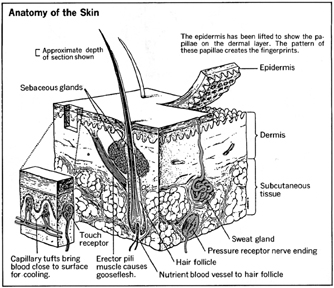Skin, Hair, and Nails
P erhaps no other organ of the human body receives so much attention both from its owner and the eyes of others as the skin and its associated structures—hair and nails.
Vanity is hardly the issue. The simple facts are that skin is the last frontier of our internal selves, the final boundary between our inside and outside, and our principal first line of defense against the dangers of the outside world. It shows, not always clearly, evidence of some internal disorders; and it shows, often quite clearly, the evidence of external affronts—a bump, a cut, a chafe, an insect bite, or an angry reaction to the attack of germs.
In personal encounters, the unclothed portion of our skin is one of the first things other people observe, and—if we happen to have some unsightly scratch, rash, or blemish—the last thing by which we wish to be remembered. Of all our organs, the skin is the most likely candidate for a program of self-improvement.

Oil Glands
The skin's oil-producing (or sebaceous ) glands are almost always associated with hair follicles, into which they seep their oils (or sebum ). The oily substance works its way up toward the surface, lubricating both the hair and outer layers of epidermis, which need continual lubrication in order to stay soft and flexible. Also, skin oils serve as a kind of protective coat against painful drying and chapping.

Comment about this article, ask questions, or add new information about this topic: